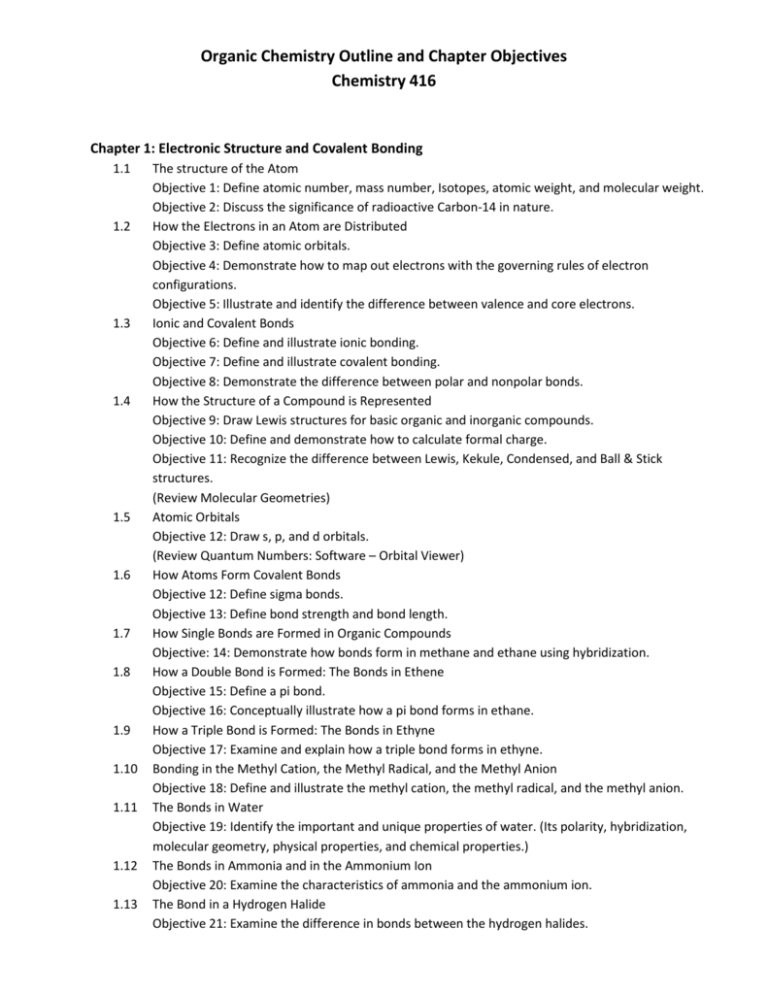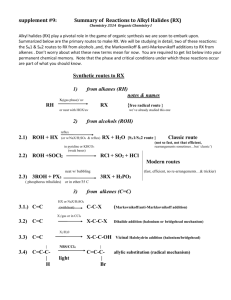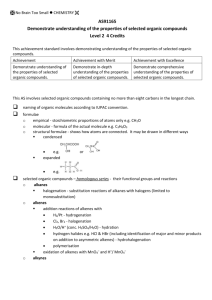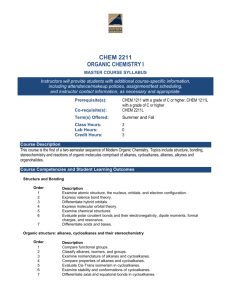Organic Chemistry Outline and Chapter Objectives Chemistry 416
advertisement

Organic Chemistry Outline and Chapter Objectives Chemistry 416 Chapter 1: Electronic Structure and Covalent Bonding 1.1 1.2 1.3 1.4 1.5 1.6 1.7 1.8 1.9 1.10 1.11 1.12 1.13 The structure of the Atom Objective 1: Define atomic number, mass number, Isotopes, atomic weight, and molecular weight. Objective 2: Discuss the significance of radioactive Carbon-14 in nature. How the Electrons in an Atom are Distributed Objective 3: Define atomic orbitals. Objective 4: Demonstrate how to map out electrons with the governing rules of electron configurations. Objective 5: Illustrate and identify the difference between valence and core electrons. Ionic and Covalent Bonds Objective 6: Define and illustrate ionic bonding. Objective 7: Define and illustrate covalent bonding. Objective 8: Demonstrate the difference between polar and nonpolar bonds. How the Structure of a Compound is Represented Objective 9: Draw Lewis structures for basic organic and inorganic compounds. Objective 10: Define and demonstrate how to calculate formal charge. Objective 11: Recognize the difference between Lewis, Kekule, Condensed, and Ball & Stick structures. (Review Molecular Geometries) Atomic Orbitals Objective 12: Draw s, p, and d orbitals. (Review Quantum Numbers: Software – Orbital Viewer) How Atoms Form Covalent Bonds Objective 12: Define sigma bonds. Objective 13: Define bond strength and bond length. How Single Bonds are Formed in Organic Compounds Objective: 14: Demonstrate how bonds form in methane and ethane using hybridization. How a Double Bond is Formed: The Bonds in Ethene Objective 15: Define a pi bond. Objective 16: Conceptually illustrate how a pi bond forms in ethane. How a Triple Bond is Formed: The Bonds in Ethyne Objective 17: Examine and explain how a triple bond forms in ethyne. Bonding in the Methyl Cation, the Methyl Radical, and the Methyl Anion Objective 18: Define and illustrate the methyl cation, the methyl radical, and the methyl anion. The Bonds in Water Objective 19: Identify the important and unique properties of water. (Its polarity, hybridization, molecular geometry, physical properties, and chemical properties.) The Bonds in Ammonia and in the Ammonium Ion Objective 20: Examine the characteristics of ammonia and the ammonium ion. The Bond in a Hydrogen Halide Objective 21: Examine the difference in bonds between the hydrogen halides. 1.14 Summary: Hybridization, Bond Lengths, Bond Strengths, and Bond Angles Objective 22: Interconnect the relationships between Chapter 2: Acids and Bases 2.1 An Introduction to Acids and Bases Objective 1: Define and identify acids, bases, conjugate acids, and conjugate bases in a given reaction. 2.2 pKa and pH Objective 2: Relate pKa, pH, and the strength of an acid. Objective 3: Mathematically calculate the pH and pKa of an acid solution. 2.3 Organic Acids and Bases Objective 4: Graphically illustrate the acidity and basicity of several organic reactions. 2.4 How to Predict the Outcome of an Acid-Base Reaction Objective 5: Qualitatively predict the products of an organic acid-base reaction. 2.5 How to Determine the Position of Equilibrium Objective 6: Qualitatively identify equilibrium shift by examining pKa’s of the acid and conjugate acid. 2.6 How the Structure of an Acid Affects its pKa Objective 7: Discuss the significance of structure and electronegativies in determining pKa for an organic compound. Objective 8: Examine and discuss acid strength of several organic compounds. 2.7 How pH Affects the Structure of an Organic Compound Objective 9: Systematically predict the behavior of an acid by examining the pH of both the acid compound and the solvent in a solution. 2.8 Buffer Solutions Objective 10: Define and illustrate how a buffer solution works to minimize pH change upon the introduction of an acid. (Case study: Blood’s Buffers) 2.9 Lewis Acids and Bases Objective 11: Define Lewis acid and Lewis base and compare it to the traditional definitions of acids and bases. Chapter 3: An Introduction to Organic Compounds 3.1 How Alkyl Substituents Are Named Objective 1: Identify and name the basic alkyl groups. Objective 2: Identify the functional groups for alcohols, amines, and halides. Objective 3: Distinguish between a primary , secondary, and tertiary carbons. 3.2 The Nomenclature of Alkanes Objective 4: List and apply the IUPAC steps for systematically naming alkane structures. 3.3 The Nomenclature of Cycloalkanes Objective 5: Identify cycloalkanes and systematically name. 3.4 The Nomenclature of Alkyl Halides Objective 6: Systematically name alkane compounds that contain halides. 3.5 The Classification of Alkyl Halides, Alcohols, and Amines. Objective 7: Distinguish the difference between primary, secondary, and tertiary class compounds. 3.6 The Structures of Alkyl Halides, Alcohols, Ethers, and Amines. Objective 8: Examine, in detail (including hybridization and orbital geometry), the structures of alkyl halides, alcohols, and amines. 3.7 The Physical Properties of Alkanes, Alkyl Halides, Alcohols, Ethers, and Amines. Objective 9: Review the different types of intermolecular forces first discussed in inorganic chemistry. Objective 10: Discuss how intermolecular forces influences boiling, melting point, and other physical properties. Objective 11: Examine the basic principles of solubility. 3.8 Rotation Occurs about Carbon-Carbon Single Bonds Objective 12: Define and identify the different types of conformations. Objective 13: Examine the 3-dimensional spatial arrangement of alkane structures. (Specifically around the carbon-carbon single bond.) 3.9 Some Cycloalkanes Have Angle Strain Objective 14: Define angle strain and identify its affect on bond strength. 3.10 Conformers of Cyclohexanes Objective 15: Identify and examine the boat and chair conformations of cyclohexane. Objective 16: Define and label axial and equatorial bonds around a cycloalkane. 3.11 Conformers of Monosubstituted Cyclohexanes Objective 17: Discuss how the addition of a substituted group affects conformation strain. 3.12 Conformers of Disubstituted Cyclohexanes Objective 18: Define cis-trans configurations of cycloalkanes and ring flip. Objective 19: Examine energetically the ring flip of several disubstituted cycloalkanes. 3.13 Fused Cyclohexane Rings Objective 20: Identify and examine fused cyclohexane rings. Chapter 4: Alkenes-Structure, Nomenclature, Stability, and an Introduction to Reactivity. 4.1 Molecular Formulas Objective 1: Define and identify saturated and unsaturated hydrocarbons. 4.2 The Nomenclature of Alkenes Objective 2: List and apply the IUPAC steps for systematically naming alkene hydrocarbons. 4.3 The Structure of Alkenes Objective 3: Examine the structure of alkenes. 4.4 Alkenes Can Have Cis-Trans Isomers Objective 4: Determine when Cis-Trans labels can be applied to an alkene compound. 4.5 Naming Alkenes Using the E,Z System Objective 5: List the steps and apply the E,Z system to naming alkenes that have multiple geometric isomers. 4.6 The Relative Stabilities of Alkenes Objective 6: Examine the energetic stability of the structures of an alkene isomer. 4.7 How Alkenes React Objective 7: Define functional group, electrophile, and nucleophile. Objective 8: Discuss how mechanisms are used to describe, in detail, a chemical reaction. Objective 9: Use curved arrows to illustrate the process of bonds breaking and forming in a chemical reaction. 4.8 A Reaction Coordinate Diagram Describes the Energy Changes that Take Place During a Reaction. Objective 10: Define and give examples of a transition state. Objective 11: Illustrate the fluctuation in energy during a reaction with a reaction coordinate diagram. Objective 12: Use the concepts of Gibs free energy to examine qualitatively the favorability of a reaction. Objective 13: Identify the factors that determine the rate of reaction. Chapter 9: Substitution and Elimination Reactions of Alkyl Halides 9.1 9.2 9.3 9.4 9.5 9.6 9.7 9.8 9.9 9.10 9.11 9.12 9.13 How Alkyl Halides React Objective 9.1: Define and identify substitution and elimination reaction. Objective 9.2: Give a qualitative explanation to why alkyl halides react. The mechanism of an Sn2 Reaction Objective 9.3: Discuss how concentration of a reagent may or may not effect reaction rate. Objective 9.4: Define molecular rates and identify the three pieces of experimental evidence that supports the multistep mechanism. Objective 9.5: Define steric effects and steric hindrance and it’s effect on reactivity. Factors That Affect SN2 Reactions Objective 9.6: Illustrate the two factors affecting SN2 reaction rates; leaving group and the nucleophile. Objective 9.7: Illustrate the mechanism for an SN1 reaction. Objective 9.8: Examine the energy coordinate diagram for an SN1 reaction. Objective 9.9: Examine and compare factors affecting SN1 reactions. Objective 9.10: Compare and examine the contrast and similarities between SN2 and SN1 reactions. (Using table 9.3) Objective 9.11: Examine elimination reactions of alkyl halides. Objective 9.12: Illustrate the mechanisms for E1 and E2 reactions. Objective 9.13: Identify the products of elimination reactions and examine the driving force behind them. Objective 9:14: Compare and contrast E2 and E1 reactions. Objective 9.15: Identify and discuss the rate law expressions for both SN2/E2 and SN1/E1 pairings. Objective 9.16: Predict whether a reaction with an alkyl halide will undergo SN1, SN2, E1, or E2 type of reaction. Objective 9.17: Examine the impact of the solvent on substitution and elimination reactions. Objective 9.18: Demonstrate how substitution reactions can be used to synthesize organic compounds. Chapter 10: Reactions of Alcohols, Amines, Ethers, and Epoxides 10.1 10.2 10.3 10.4 10.5 10.6 10.7 10.8 Objective 10.1: Use IUPAC nomenclature rules to name alcohols. Objective 10.2: Examine and demonstrate substitution reactions involving alcohols. Objective 10.3: Examine and demonstrate the dehydration of alcohols. Objective 10.4: Examine, demonstrate, and predict reactions involving the oxidation of alcohols to form ketones and aldehydes. Objective 10.5: Discuss and illustrate why amines do not undergo substitution or elimination reactions. Objective 10.6: Use IUPAC nomenclature rules to name ethers. Objective 10.7: Examine and illustrate nucleophilic substitution reactions of ethers. Objective 10.8: Illustrate and predict reactions of epoxides forming a variety of organic compounds. Objective 10.9: Examine and use correct reactants to form epoxides.








